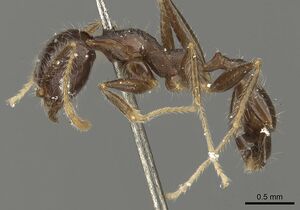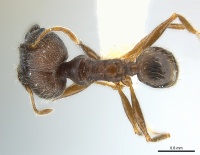Pheidole aurivillii
| Pheidole aurivillii | |
|---|---|

| |
| Scientific classification | |
| Kingdom: | Animalia |
| Phylum: | Arthropoda |
| Class: | Insecta |
| Order: | Hymenoptera |
| Family: | Formicidae |
| Subfamily: | Myrmicinae |
| Tribe: | Attini |
| Genus: | Pheidole |
| Species: | P. aurivillii |
| Binomial name | |
| Pheidole aurivillii Mayr, 1896 | |
| Subspecies | |
| |
Reported severally from West Africa and the Congo Basin. In Benin, Taylor et al. (2018) found this species to be ground nesting in mango (Mangifera indica) orchards where it was prey of Oecophylla longinoda.
Identification
A member of the aurivillii species group.
Distribution
Latitudinal Distribution Pattern
Latitudinal Range: 0.45556° to -19.00781°.
| North Temperate |
North Subtropical |
Tropical | South Subtropical |
South Temperate |
- Source: AntMaps
Distribution based on Regional Taxon Lists
Afrotropical Region: Benin, Cameroun (type locality), Guinea, Kenya, Uganda.
Distribution based on AntMaps
Distribution based on AntWeb specimens
Check data from AntWeb
Countries Occupied
| Number of countries occupied by this species based on AntWiki Regional Taxon Lists. In general, fewer countries occupied indicates a narrower range, while more countries indicates a more widespread species. |

|
Estimated Abundance
| Relative abundance based on number of AntMaps records per species (this species within the purple bar). Fewer records (to the left) indicates a less abundant/encountered species while more records (to the right) indicates more abundant/encountered species. |

|
Biology
Castes
Images from AntWeb
   
| |
| Worker. Specimen code casent0217103. Photographer Erin Prado, uploaded by California Academy of Sciences. | Owned by CAS, San Francisco, CA, USA. |
    
| |
| Not Provided. Worker. Specimen code casent0283192. Photographer Adam Lazarus, uploaded by California Academy of Sciences. | Owned by EPEC. |
   
| |
| Syntype of Pheidole aurivillii. Worker. Specimen code casent0901298. Photographer Ryan Perry, uploaded by California Academy of Sciences. | Owned by NHMUK, London, UK. |
   
| |
| Syntype of Pheidole aurivillii. Worker (major/soldier). Specimen code casent0901299. Photographer Ryan Perry, uploaded by California Academy of Sciences. | Owned by NHMUK, London, UK. |
Nomenclature
The following information is derived from Barry Bolton's Online Catalogue of the Ants of the World.
- aurivillii. Pheidole aurivillii Mayr, 1896: 238 (s.w.) CAMEROUN. Santschi, 1910c: 369 (m.). Current subspecies: nominal plus attenuata, kasaiensis, rubricalva.
Description
References
- Mayr, G. 1896. Beiträge zur Kenntniss der Insektenfauna von Kamerun. 5. Formiciden gesammelt von Herrn Yngve Sjöstedt. Entomol. Tidskr. 17: 225-252 (page 238, soldier, worker described)
- Santschi, F. 1910c [1909]. Formicides nouveaux ou peu connus du Congo français. Ann. Soc. Entomol. Fr. 78: 349-400 (page 369, male described)
- Taylor, B., Agoinon, N., Sinzogan, A., Adandonon, A., Kouaguou, Y. N., Bello, S., Wargui, R., Anato, F., Ouagoussounon, I., Houngbo, H., Tchibozo, S., Todjihounde, R., Vayssieres, J.F. 2018. Records of ants (Hymenoptera: Formicidae) from the Republic of Benin, with particular reference to the mango farm ecosystem. Journal of Insect Biodiversity 8(1): 6-29 (doi:10.12976/jib/2018.08.1.2).
References based on Global Ant Biodiversity Informatics
- Eidmann H. 1944. Die Ameisenfauna von Fernando Poo. 27. Beitrag zu den Ergebnissen der Westafrika-Expedition. Zool. Jahrb. Abt. Syst. Ökol. Geogr. Tiere 76: 413-490.
- Garcia F.H., Wiesel E. and Fischer G. 2013.The Ants of Kenya (Hymenoptera: Formicidae)Faunal Overview, First Species Checklist, Bibliography, Accounts for All Genera, and Discussion on Taxonomy and Zoogeography. Journal of East African Natural History, 101(2): 127-222
- Menozzi C. 1942. Formiche dell'isola Fernando Poo e del territorio del Rio Muni (Guinea Spagnola). 24. Beitrag zu den wissenschaftlichen Ergebnissen der Forschungsreise H. Eidmann nach Spanisch-Guinea 1939 bis 1940. Zoologischer Anzeiger 140: 164-182.
- Ross S. R. P. J., F. Hita Garcia, G. Fischer, and M. K. Peters. 2018. Selective logging intensity in an East African rain forest predicts reductions in ant diversity. Biotropica 1-11.
- Santschi F. 1910. Formicides nouveaux ou peu connus du Congo français. Annales de la Société Entomologique de France 78: 349-400.
- Santschi F. 1914. Formicides de l'Afrique occidentale et australe du voyage de Mr. le Professeur F. Silvestri. Bollettino del Laboratorio di Zoologia Generale e Agraria della Reale Scuola Superiore d'Agricoltura. Portici 8: 309-385.
- Stephens S. S., P. B. Bosu, and M. R. Wager. 2016. Effect of overstory tree species diversity and composition on ground foraging ants (Hymenoptera: Formicidae) in timber plantations in Ghana. International Journal of Biodiversity Science, Ecosystem Services & management 12(1-2): 96-107.
- Taylor B., N. Agoinon, A. Sinzogan, A. Adandonon, Y. N'Da Kouagou, S. Bello, R. Wargui, F. Anato, I. Ouagoussounon, H. Houngbo, S. Tchibozo, R. Todjhounde, and J. F. Vayssieres. 2018. Records of ants (Hymenoptera: Formicidae) from the Republic of Benin, with particular reference to the mango farm ecosystem. Journal of Insect Biodiversity 8(1): 006–029.
- Vanthomme H., A. Alonso, E. Tobi, C. L. Rolegha, F. Hita Garcia, J. B. Mikissa, and L. E. Alonso. 2017. Associations of ant species to land cover types and human disturbance in south-west Gabon. African Journal of Ecology DOI: 10.1111/aje.12362
- Wheeler W. M. 1922. Ants of the American Museum Congo expedition. A contribution to the myrmecology of Africa. VIII. A synonymic list of the ants of the Ethiopian region. Bulletin of the American Museum of Natural History 45: 711-1004

